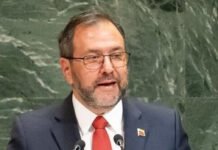U.S. Pulls Out of Ceasefire Talks Amid Accusations Against Hamas
In a dramatic escalation of diplomatic tensions, the United States abruptly withdrew its delegation from the Gaza ceasefire negotiations in Doha, Qatar, accusing Hamas of insincerity and obstruction. President Donald Trump’s special envoy, Steve Witkoff, issued a firm statement, declaring that Hamas is not engaging honestly in dialogue and lacks the commitment to peace. This withdrawal came after months of indirect negotiations mediated by Qatar, Egypt, and the U.S., which had sought to end the 18-month-long Israel-Hamas conflict that has ravaged the Gaza Strip and pushed the region to the brink of humanitarian catastrophe.
Israel Follows U.S. Lead, Calls Back Negotiating Team
Shortly after the U.S. announcement, Israeli Prime Minister Benjamin Netanyahu ordered his negotiating team to return from Qatar, signaling a synchronized diplomatic stance with Washington. While Netanyahu’s office acknowledged the role of international mediators, it refrained from offering detailed reasons behind the decision, reflecting a shared frustration with Hamas’s hardened position.
Ceasefire Proposal Collapses Over Core Disputes
The breakdown of talks marks a major setback for what was shaping up to be a potentially breakthrough ceasefire. The proposed framework included a 60-day truce, during which Hamas would release 10 live Israeli hostages and the bodies of 18 deceased captives in exchange for the phased release of Palestinian prisoners and a surge in humanitarian aid to the battered enclave. However, Hamas countered with preconditions unacceptable to Israel—a full withdrawal of Israeli forces and a permanent end to the war.
Israel, on the other hand, maintains that it will not cease military operations until Hamas is removed from power and fully disarmed. These irreconcilable differences have now derailed months of painstaking negotiations, dashing hopes for a near-term resolution.
Gaza’s Humanitarian Crisis Deepens: Starvation Grips the Population
As diplomacy collapses, the humanitarian emergency in Gaza is worsening at a staggering rate. The United Nations reports that over 100,000 women and children in Gaza are suffering from acute malnutrition, while local hospitals have registered rising deaths from starvation and disease. The Gaza Health Ministry has officially confirmed a spike in hunger-related fatalities, particularly among infants and the elderly.
Last Sunday, at least 85 Palestinians were killed in what has been described as the deadliest food aid incident so far, as thousands gathered in desperation for rations. Aid groups on the ground are warning of an imminent famine if immediate, unrestricted humanitarian corridors are not established.
Aid Blockages and Infrastructure Collapse Exacerbate the Crisis
Despite claims by Israel that adequate aid is being delivered, United Nations officials and multiple NGOs insist that ongoing restrictions, infrastructure destruction, and security breakdowns are preventing assistance from reaching the most vulnerable. Over 100 aid organizations and human rights groups have jointly condemned the blockade, labeling the situation a “man-made famine”.
The U.S., while defending its aid operations, revealed it has dispatched over 90 million meal packs into Gaza. However, multiple independent assessments suggest that only a fraction of this aid is reaching those in dire need, largely due to logistical and political barriers within the conflict zone.
Global Condemnation Intensifies as Gaza Burns
The collapse of peace talks and the worsening humanitarian outlook have sparked fierce criticism from the international community. 28 Western nations, including major EU powers, have openly condemned Israel’s conduct, calling for an immediate cessation of hostilities and unhindered humanitarian access. Simultaneously, these nations have urged Hamas to release hostages without preconditions and to commit to constructive diplomacy.
In capitals across Europe, protests have erupted, demanding stronger action from the international community and accountability for war crimes. Calls for an independent international investigation into alleged violations by both Israel and Hamas are gaining momentum.
Trump’s Middle East Peace Aspirations Falter
President Donald Trump, who had positioned himself as a key facilitator of peace in the Middle East, now faces a significant setback. His earlier White House meeting with Netanyahu was touted as a diplomatic milestone. However, the current impasse—and the continued bloodshed and starvation in Gaza—is raising doubts about Washington’s ability to influence outcomes in the region.
Trump had previously vowed to end the Russia-Ukraine conflict, yet similar stagnation and gridlock have marked that theater as well. Critics argue that the withdrawal from Gaza negotiations reflects a broader erosion of U.S. diplomatic leverage under the Trump administration.
Hamas’s Strategy Under Scrutiny
Analysts are now questioning Hamas’s objectives and negotiation strategy. By rejecting what many considered a generous interim deal, the militant group has left Gaza’s civilian population to bear the brunt of continued warfare. Sources close to the negotiations suggest that Hamas leadership remains entrenched in maximalist goals, including international recognition and total Israeli withdrawal, which appear increasingly disconnected from the on-ground suffering of Palestinians.
The Road Ahead: What Options Remain?
With talks suspended and Gaza descending deeper into crisis, the path forward remains unclear. U.S. envoy Steve Witkoff hinted at “other options”, but provided no specifics. Speculation ranges from unilateral humanitarian airlifts to covert operations aimed at hostage rescue, or even renewed pressure on regional powers like Turkey and Iran to influence Hamas.
In Israel, calls are growing louder from some quarters for a full-scale reoccupation of Gaza, while others advocate for a political solution brokered by a neutral third party, possibly under the aegis of the United Nations or Arab League.
The Human Toll Continues to Mount
Since the conflict began over 18 months ago, tens of thousands of Palestinians have been killed or displaced, with entire neighborhoods reduced to rubble. Schools, hospitals, and places of worship lie in ruins. The cost in civilian lives, especially children, has drawn global outrage and prompted comparisons to some of the darkest chapters in recent memory.
The psychological trauma, loss of infrastructure, and collapse of essential services suggest that even a ceasefire now may not be enough to reverse the damage. Generations of children are growing up amidst war, hunger, and despair—a haunting legacy for all parties involved.
Conclusion: A Turning Point or a Tipping Point?
The U.S. withdrawal from Gaza ceasefire talks marks a critical turning point in this prolonged and devastating conflict. With both Hamas and Israel holding firm to irreconcilable demands, and with humanitarian conditions reaching unprecedented lows, the international community must now confront the limits of diplomacy in the face of entrenched hostility.
Absent bold, coordinated action, the region risks spiraling into a deeper abyss of violence, starvation, and generational trauma. The world is watching—but for Gaza’s civilians, time is running out.
















